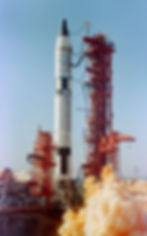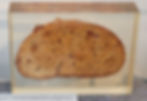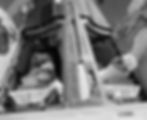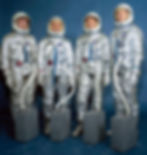Gus, John, and Molly Brown: 5 Fun Facts About Gemini 3
- Aeryn Avilla
- Mar 23
- 11 min read
Updated: 2 hours ago
If you'd rather watch a video than read this post, click here to be redirected to my YouTube channel!
March 23, 2025 is the 60th anniversary of Gemini 3, the first manned flight of the Gemini program. The mission's command pilot was Gus Grissom, the second American in space and veteran of Mercury-Redstone 4. The pilot was rookie John Young, the first from NASA's second group of astronauts, the New Nine, to fly in space. The crew's backup astronauts were Wally Schirra and Tom Stafford, future prime crew of Gemini 6A. Let's look at five interesting facts about Gemini 3!

1. The Unsinkable Molly Brown
Naming aircraft is a long standing and loved tradition in aviation— Spirit of St. Louis, Enola Gay, and Glamorous Glennis just to name a few. The Mercury astronauts, all of whom were military pilots, carried this tradition into space by naming their capsules. Project Gemini intended to continue this practice.
According to Calculated Risk: The Supersonic Life and Times of Gus Grissom by George Leopold, Grissom first considered naming his spacecraft Wapasha after several Mdewakanton Dakota chiefs who lived in Minnesota during the 18th and 19th centuries. However, after someone pointed out to Grissom that the spacecraft would be nicknamed the Wabash Cannon Ball, a mythical train described in the American folk song of the same name, Wapasha was dropped. Grissom and Young agreed on the name Molly Brown after the popular broadway show The Unsinkable Molly Brown as a nod to Grissom's sunken Liberty Bell 7 capsule (more on that later) [1]. NASA was not amused and made the crew choose another name. Grissom suggested Titanic. NASA was less amused by that one, so they reluctantly allowed Molly Brown. In fact, NASA disliked the name so much that it prohibited its astronauts from naming their spacecraft until 1969 with Apollo 9.
Though Gemini 5 was the first crew to wear embroidered space patches on their spacesuits, the astronauts of Gemini 3 and Gemini 4 designed their own insignia. Grissom and Young carried silver medallions with artwork of a Gemini capsule in the ocean. The inclusion of the crew's first and last names and middle initials is unique to Gemini 3's and Gemini 4's medallions. Young had physical patches produced for himself sometime post-flight and wore it on flight suits throughout his career.

2. Second Time Around
Gemini 3 marked the first time a person had flown in space twice. On July 21, 1961, Grissom became the second American in space onboard the 15-minute suborbital Mercury-Redstone 4 mission. Paying homage to the Mercury Seven astronauts and to the United States, Grissom named his Mercury spacecraft Liberty Bell 7, because in his words, his capsule was "shaped like a bell." After splashdown in the Atlantic Ocean, the explosive hatch blew prematurely, causing water to flood into the capsule. Grissom was safely recovered but Liberty Bell 7, too heavy to hoist, sank to the bottom of the ocean. This event was what inspired the name Molly Brown for Gemini 3's spacecraft.
While Grissom was the first person to fly in space twice, Gordon Cooper, sole pilot of Mercury-Atlas 9 and command pilot of Gemini 5, was the first person to complete two orbital spaceflights. Alan Shepard, the first American in space, was the original command pilot of Gemini 3 but was grounded in 1963 due to Meniere's disease, an inner ear disorder. He was Chief of the Astronaut Office during the Gemini program. Of the seven Mercury astronauts, four flew in space twice (Shepard, Grissom, Glenn, and Cooper) and one flew three times (Schirra).

3. Two of a Kind
Gemini 3 was also the first two-man American space mission [2]. The two-person Project Gemini was approved by NASA in December 1961 as the bridge from the sole-pilot Project Mercury to the lunar Project Apollo. Originally called Mercury Mark II, Gemini is named after the constellation of the same name, also the Latin word for "twins".
Gemini 3 lifted off from Launch Complex-19 on Cape Kennedy on Tuesday, March 23, 1965 at 9:24 AM local time. It was the first manned launch of a Titan rocket and the first manned launch from LC-19.

The Titan II Gemini Launch Vehicle was a two-stage liquid fuel man-rated launch vehicle derived from the Titan II intercontinental ballistic missile. They were manufactured by Martin, had a height of 109 feet (33 m), a diameter of 10 feet (3 m), and a payload to LEO capacity of 7,900 pounds (3.6 tons). Its first stage was powered by a single Aerojet LR87 engine (with two combustion chambers and nozzles) and the second stage was powered by a single Aerojet LR91 engine. Both engines used Aerozine 50 as fuel and nitrogen tetroxide as oxidizer. Aerozine 50 was developed by Aerojet specifically for the Titan II rocket and was later used by the Apollo Lunar Modules.

A quirk with the Gemini-Titan II was the holes in its fuselage. The rocket's second stage engine burned while the first stage was still attached. According to John Young in a 1998 interview with Smithsonian Magazine, this was called "fire in the hole". To prevent the buildup of hot gasses, sixteen rectangular exhaust ports were located at the forward end of the first stage's fuselage to vent the gas as the LR91 engine burned. The Gemini-Titan II was the only human-rated Titan launch vehicle.
Launch Complex-19 was built in the late 1950s to support Titan rocket launches. After 15 Titan I launches from 1959 to 1962, it was converted to support Titan II Gemini Launch Vehicles, 12 of which (10 manned and 2 unmanned) launched from 1964 to 1966. The most notable modification was the addition of a white room, an environmentally controlled room that contained and processed the Gemini spacecraft before liftoff. It sat atop the booster erector. In spring 1967, the complex was deactivated and mothballed. Its service tower and umbilical were demolished in 1977 and the launch pad was demolished in the early 2010s. Fortunately, the white room was restored in 2003 and moved to the Air Force Space and Missile Museum (now the Cape Canaveral Space Force Museum), where it still sits.
Gemini 3 was also the final mission controlled from Florida instead of Houston, Texas. It and the prior Mercury flights were controlled by the Mercury Control Center on Cape Kennedy. The MCC was added to the National Register of Historic Places in 1984 and served as a bus stop for tourists visiting the Cape until the 1990s. The building, full of asbestos and in poor condition due to decades of exposure to the coast's salty air, was demolished in 2010. Fortunately, the control room consoles were rescued and refurbished and can now be seen in their original configuration at the Kennedy Space Center Visitor Complex. The Mission Control Center at the Manned Spacecraft Center in Houston, Texas, monitored Gemini 3 during flight. Capsule Communicators for Gemini 3 were Gordon Cooper at the Cape and rookie Roger Chaffee in Houston.

There have been a number of two-person missions in American space history, beginning with the ten manned flights of the Gemini program in 1965 and 1966. The first four flights of the Space Shuttle (STS-1 through STS-4) carried two astronauts each. As of 2025, there have been three American two-person space missions in the 2020s: SpaceX Demo-2, the crewed test flight of SpaceX Crew Dragon, and Boeing Crew Flight Test, the crewed test flight of Boeing Starliner, both had a crew of two. SpaceX Crew-9 was scheduled to transport a crew of four to the International Space Station, but due to technical issues with Starliner, launched with a crew of only two. The Soviet Union conducted a number of two-person missions in the 60s, 70s, and 80s.


4. Food that's "Out of this World"
Off A1A in Cocoa Beach at the Ramada Inn stood Wolfie's Restaurant, a family-friendly joint frequently visited by astronauts. One of Gemini 3's mission objectives was to evaluate NASA's new in-flight food packaging, reconstitution method, and taste. Space food flown on prior Mercury missions came in toothpaste-like tubes and in the form of crumbly, bite-sized cubes. During Gemini, NASA had its astronauts try food cubes coated in gelatin to minimize crumbling and rehydrating food with a water gun. Astronauts did not like the cold, mushy food.
Wally Schirra, backup command pilot and one of Grissom's friends, got the bright idea to have John Young bring a fresh sandwich on the flight to surprise Grissom. Schirra purchased a corned beef on rye from Wolfie's and Young smuggled it in the pocket of his flight suit. About two hours into the flight, Young pulled out the sandwich and presented it to his commander. Grissom took a bite, neither he nor Young expecting the smell to be so pungent. Crumbs and caraway seeds began to fill the small cabin so Grissom shoved the sandwich into his suit pocket. It was a miracle the crumbs didn't interfere with the spacecraft's electronics. And that would've been the end of the story had no one back on Earth taken notice.
Young and Grissom during suit-up. Grissom is talking with Schirra (NASA)
This 30-second stunt drew scrutiny from Congress and NASA Administrator James Webb, who felt the Manned Spacecraft Center needed to tighten its reins on its astronauts. George Mueller, the head of the Office of Manned Space Flight, promised Representative George Shipley, who was especially appalled at the astronauts' antics, that NASA would take steps "to prevent recurrence of corned beef sandwiches in future flights," while clarifying there was "no detriment to the experimental program that was carried on, nor was there any detriment to the actual carrying out of the mission because of the ingestion of the sandwich." Manned Spacecraft Center Director Bob Gilruth was more lenient, telling Congress that humor helps "break up the strain" of spaceflight. His boss Webb disagreed, stating the stunt "was not an adequate performance by an astronaut." Remember, this was over a sandwich. And it didn't even have mustard.
Neither Grissom, Young, nor Schirra, who orchestrated the whole thing to begin with, received any reprimand. Sixty years later, the infamous sandwich is probably what the first manned Gemini mission is most remembered for. True to Mueller's word, no corned beef sandwich ever flew in space again...with one exception: In 1981, when Young commanded his fifth spaceflight and the first flight of the Space Shuttle program, space-rated corned beef sandwich cubes were on his menu.

5. Orbit with Me
At the end of its first orbit, Gemini 3 became the first manned mission to perform an orbital maneuver. The spacecraft's Orbit Attitude and Maneuvering System engines burned for 1 minute and 14 seconds to lower Gemini 3's orbit from 100 miles x 139 miles (161 km x 224 km) to a near-circular 97 miles x 105 miles (156 km x 169 km). It burned for a second time 45 minutes later to change the spacecraft's orbital inclination by only 0.02 degrees. Near the end of their third and final orbit, the OAMS fired to lower Gemini 3's perigee to 45 miles so in the event its retrorockets failed to ignite, the spacecraft would still reenter the atmosphere.
Gemini 3 also evaluated the worldwide tracking network and Gemini spacecraft systems. The Manned Space Flight Network was a collection of tracking stations located around the world that supported the Mercury, Gemini, Apollo, and Skylab programs. The Gemini network consisted of 24 sites.
Molly Brown is now on display at the Virgil I. "Gus" Grissom Memorial Museum in Mitchell, Indiana.

Honorable Mention: The Fighting I
After 4 hours and 52 minutes in space, Gemini 3 splashed down in the Atlantic Ocean near Grand Turk Island and was recovered by the USS Intrepid. The USS Intrepid, known as The Fighting "I", was an Essex-class aircraft carrier built during World War II and participated in several campaigns in the Pacific Theater, including the Battle of Leyte Gulf, the largest naval battle of the Second World War. In the 1950s, she was converted to support modern jet aircraft and alternated between operating in the Atlantic Ocean and deploying to the Mediterranean Sea. After refitting as an anti-submarine carrier in the early 1960s, she recovered astronaut Scott Carpenter in 1962. After retrieving Gemini 3 and its crew, Intrepid served in the Vietnam War and NATO exercises, and was decommissioned in March 1974. She was saved from being scrapped and opened as a museum ship— the Intrepid Sea, Air, and Space Museum— on the Hudson River in New York City in 1982. The ship was designated a National Historic Landmark in 1986 and served as the FBI operations center after the September 11, 2001 terrorist attacks. In 1988, the USS Growler, one of only two nuclear-armed conventional diesel-electric submarines, joined Intrepid at Pier 86, and since 2012, the carrier has housed Space Shuttle Enterprise.

After serving as backup command pilot for Gemini 6A, Grissom was transferred to the Apollo program and assigned as commander of its first manned mission. He and his crew mates Ed White and Roger Chaffee were killed when their spacecraft's cockpit caught fire on the launch pad on January 27, 1967. Young flew in space another five times— as command pilot of Gemini 10 (1966), command module pilot of Apollo 10 (1969), commander of Apollo 16 (1972), commander of STS-1 (1981), and commander of STS-9 (1983)— and served as Chief of the Astronaut Office from 1974 to 1987. Retiring in 2004, Young is the longest-serving astronaut in history. In 2010, a replica Gemini Launch Vehicle 3 made from a restored Air Force Titan II missile and a mockup Gemini capsule was erected at the Kennedy Space Center Visitor Complex's Rocket Garden.
Gemini 3 was a big success and the jumping-off point for the highly ambitious Gemini program. The next mission, Gemini 4, would push the human body to its limits by having an astronaut "walk" in space.

Author's note: Thanks for reading and be sure to like and share this post!
[1] The Unsinkable Molly Brown is about the real-life Margaret Brown, a socialite and philanthropist who survived the sinking of the RMS Titanic in 1912 and helped with the ship's evacuation. A lifelong suffrage and humans rights advocate, she also financially backed several elementary schools, helped establish the first juvenile court in the US, and earned the French Legion of Honor for her work with the American Committee for Devastated France and the Red Cross during and after World War I.
[2] The Soviet Voskhod 2 (launched on March 18, 1965) was the first two-person space mission in history. The mission before it, Voskhod 1 (October 1964), was the first multi-person space mission (it carried a crew of three).
Bibliography
Angle, D. C. "Riding the Titan II." Smithsonian Magazine, September 1998. https://www.smithsonianmag.com/air-space-magazine/riding-the-titan-ii-223545/
Boyer, Charles. "Wolfie's - Corned Beef on High." Me and Old Man Par, 2022. https://old-man-par.com/2022/04/15/wolfies-corned-beef-on-high/
Cosgrove, Neil. "Unsinkable & Unstoppable: The Real Margaret 'Molly' Brown." The Ancient Order of Hibernians, March 2025. https://aoh.com/2025/03/18/unsinkable-and-unstoppable-the-true-story-of-margaret-molly-brown/
"Gemini 3." National Space Science Data Coordinated Archive. https://nssdc.gsfc.nasa.gov/nmc/spacecraft/display.action?id=1965-024A
"Launch Complex 19." Cape Canaveral Space Force Museum. https://ccspacemuseum.org/facilities/launch-complex-19/
Leopold, George. Calculated Risk: The Supersonic Life and Times of Gus Grissom. Purdue University Press, 2016.
Pearlman, Robert Z. "Gemini-Titan Rocket Rises Again at Kennedy Space Center." space.com, September 2010. https://www.space.com/9194-gemini-titan-rocket-rises-kennedy-space-center.html
Ross-Nazzal, Jennifer. "Fallout from the Unauthorized Gemini III Space Sandwich." NASA, 2025. https://www.nasa.gov/history/fallout-from-the-unauthorized-gemini-iii-space-sandwich/
Teital, Amy Shiera. "Why Were There Holes in the Titan Rocket that Launched NASA's Gemini Missions?" Popular Science, May 2016. https://www.popsci.com/why-were-there-holes-in-titan-rocket-that-launched-nasas-gemini-missions/
"USS Intrepid (CV-11)." Naval History and Heritage Command, June 2024. https://www.history.navy.mil/browse-by-topic/ships/aircraft-carriers/uss-intrepid.html
Zorino, Mary C. "Virgil Ivan 'Gus' Grissom." NASA. https://www.nasa.gov/history/40thmerc7/grissom.htm
Intellectual Properties I don't own
"Orbit with Me" — performed by Sonny Sheather and the Stardusters
This post was written entirely without the use of AI (sorry HAL). Go Cats!






